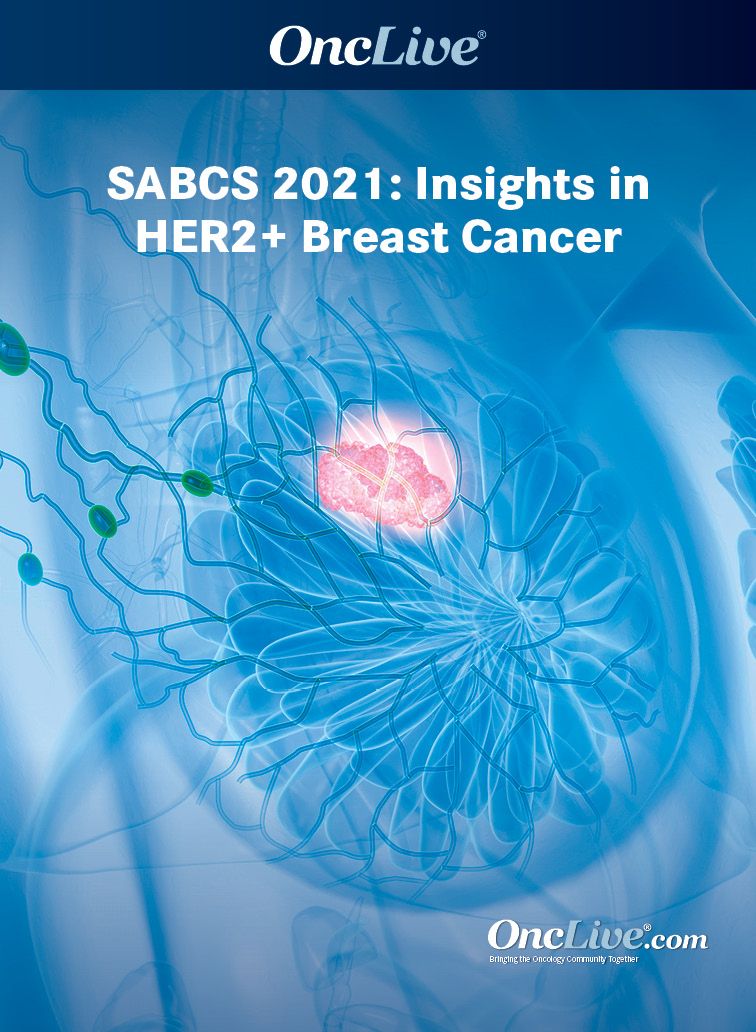Publication
Article
Supplements and Featured Publications
Neratinib Stands Out at SABCS 2021 in HER2-Mutant Metastatic Breast Cancer
Author(s):
Sara A. Hurvitz, MD, provides perspective on key research that was presented during the 2021 SABCS in HER2-positive metastatic breast cancer.
Sara A. Hurvitz, MD

Although findings from the 2021 San Antonio Breast Cancer Symposium (SABCS) were more practice affirming than practice changing, an interesting signal from the phase 2 SUMMIT trial (NCT01953926) suggests that traditional HER2-directed agents may have utility in patients with HER2 mutations, potentially broadening their utility into hormone receptor (HR)–positive and triple-negative breast cancer (TNBC), explained Sara A. Hurvitz, MD.
In the study, in patients with HR-positive, HER2-mutated metastatic breast cancer who had previously received CDK4/6 inhibitors (n = 33), neratinib (Nerlynx) plus fulvestrant (Faslodex) and trastuzumab (Herceptin) led to an objective response rate (ORR) of 42.4%, including 1 complete response (CR; 3.0%) and 13 partial responses (PR; 39.4%).1 The clinical benefit rate was 51.5%. The median duration of response (DOR) was 14.4 months (95% CI, 6.4–not evaluable [NE]), with a median progression-free survival (PFS) of 7.0 months (95% CI, 4.2-12.7). The median duration of treatment was 6.5 months (95% CI, 0.7-22.1).
In the TNBC cohort (n = 18), neratinib plus trastuzumab led to an ORR of 33.3%, including 1 CR (5.6%) and 5 PRs (27.8%); the best ORR was 38.9%. The median DOR was NE and the median PFS was 6.2 months (95% CI, 2.1-8.2). The median duration of treatment was 4.4 months (95% CI, 0.3-15.4).
“It has been an exciting year, but clearly, there are a lot more data forthcoming in the next year or two,” said Hurvitz, an associate professor in the David Geffen School of Medicine of the University of California, Los Angeles (UCLA).
In an interview with OncLive®, Hurvitz, also medical oncologist, medical director, Jonsson Comprehensive Cancer Center Clinical Research Unit, co-director, Santa Monica-UCLA Outpatient Oncology Practices, director, Breast Cancer Clinical Trials Program, UCLA, provided perspective on key research that was presented during the 2021 SABCS in HER2-positive metastatic breast cancer.
OncLive®: What are your thoughts on the findings from the phase 2 SUMMIT trial with neratinib plus trastuzumab and fulvestrant in HER2-mutated breast cancer?
Hurvitz: The SUMMIT study exploring the activity of neratinib as therapy for patients whose tumors have HER2 mutations is quite intriguing and exciting. I had the privilege of referring some patients for enrollment on that clinical trial, and I’ve seen firsthand that this combination of neratinib with fulvestrant and trastuzumab can be active even in heavily pretreated patients. I am really looking forward to seeing a larger trial exploring the use of neratinib in this setting where HER2 mutations are seen. Some patients will have HER2 mutations, usually in the absence of HER2 amplification, so it provides yet another therapy that might be beneficial in patients with HR-positive, HER2-mutated disease or triple-negative HER2-mutated disease.
Findings from the DESTINY-Breast03 trial (NCT03529110) demonstrated robust and durable antitumor activity with fam-trastuzumab deruxtecan-nxki (Enhertu; T-DXd) in patients with HER2-positive metastatic breast cancer and brain metastases. What is next for this drug in targeting HER2 in breast cancer?
The results from the DESTINY-Breast03 trial were practice changing, showing that T-DXd is associated with a prolonged median progression-free survival [PFS] compared with TDM-1 [ado-trastuzumab emtansine (Kadcyla)]. Overnight, those results changed the way that we treat patients after trastuzumab and a taxane in the metastatic setting, placing it in the second-line position, as well as in the third- and later-line positions for patients who are in that setting already.
There didn’t appear to be a subgroup that didn’t benefit from T-DXd compared with TDM-1. We saw some intriguing data suggesting that there is some benefit in patients with brain metastases, although that needs to be explored prospectively in a study that’s designed to assess that activity in patients with active brain metastases.
Several studies are ongoing and planned to further interrogate the benefits of T-DXd in the curative and metastatic settings. Studies will be looking at T-DXd in the frontline setting, head-to-head against the standard taxane/trastuzumab/pertuzumab [Perjeta] regimen, as well as in a later-line setting and in patients with brain metastases. T-DXd is also going to be looked at in patients with HER2-low expressing non-amplified breast cancer. A lot of results are going to be forthcoming in the next few years and may be practice changing. It’s a very exciting time.
Have the brain metastases data from the NALA trial (NCT01808573) affected your thoughts on treatment sequencing in the metastatic setting?
The NALA study did establish that neratinib plus capecitabine is better than lapatinib [Tykerb] plus capecitabine in the third-line setting and beyond in patients with metastatic HER2-positive breast cancer. It did show that the mean PFS was better with neratinib compared with lapatinib-based therapy, although it was only about 2 months better, and there was no significant overall survival [OS] benefit.
Patients weren’t allowed on that trial who had active brain metastases. Patients had to have stable or previously treated brain metastases. Although neratinib seemed to have slightly better outcomes in patients with brain metastases or a history of brain metastases in that trial, I don’t think that it’s changed the way we treat patients who have brain metastases currently. Currently, level 1 evidence supports the use of tucatinib [Tukysa] in patients with active brain metastases, based on the large randomized HER2CLIMB trial [NCT02614794].
Could the combination of pyrotinib and capecitabine have a role to play in metastatic HER2-positive breast cancer, given the results of the phase 3 PHOEBE trial (NCT03080805)?
Pyrotinib is another tyrosine kinase inhibitor that has been evaluated in several clinical trials, including phase 3 clinical trials. These studies were primarily conducted in Asia rather than in the United States or Europe. Interestingly, the addition of pyrotinib to capecitabine did appear to be associated with not only an improved PFS, but also OS compared with lapatinib.
Pyrotinib does appear to be quite potent, which may explain its improved efficacy. However, it comes with increased toxicity as well. The fact that pyrotinib inhibits EGFR, rather potently, in addition to HER2 explains the GI [gastrointestinal] toxicity that’s seen, so this is something that must be overcome if it’s going to be explored and later utilized in the United States where we have so many agents available that target HER2-positive breast cancer.
The therapeutic index of these very potent pan-HER inhibitors is not as ideal as we see with other HER2-targeted therapies, so I would put it lower on the priority list at this point, but I’m interested in seeing further data come out regarding this drug.
Pending further positive study with the bispecific antibody zanidatamab, how do you see that agent affecting the use of margetuximab-cmkb (Margenza), if at all?
Margetuximab is an interesting drug that targets HER2 very similarly to trastuzumab, but the tail of the antibody, that Fc portion, is designed to better engage with the immune system–effector cells in our bodies, thereby improving the ADCC [antibody-dependent cell-mediated cytotoxicity] that is stimulated by antibody therapy. Indeed, it has been shown in the phase 3 trial to improve PFS in second- and third-line HER2-positive metastatic breast cancer compared with trastuzumab by about 5 weeks or maybe 6 weeks with no significant improvement in OS.
The bispecific drug zanidatamab is very interesting and is being evaluated in early-phase trials. We haven’t yet seen phase 3 evidence of this agent, but it’s designed not only to improve outcomes for patients who have a particular Fc-gamma receptor genotype, but to improve ADCC regardless of Fc-gamma receptor genotype. The molecule is a little bit different from margetuximab. I’ll be very interested in seeing how the efficacy of this molecule compares with trastuzumab-based therapy. There are also ongoing studies looking at this molecule in combination with immune-based therapies. It’s going to be interesting to see data come out. My hope is that this agent will be well tolerated and improve upon efficacy.
Reference
- Jhaveri K, Haeseong P, Waisman J, et al. Neratinib + fulvestrant + trastuzumab for hormone-receptor positive, HER2-mutant metastatic breast cancer, and neratinib + trastuzumab for HER2-mutant metastatic triple-negative disease: latest updates from the SUMMIT trial. Presented at: 2021 San Antonio Breast Cancer Symposium; December 7-10, 2021; San Antonio, TX. Abstract GS4-10.










